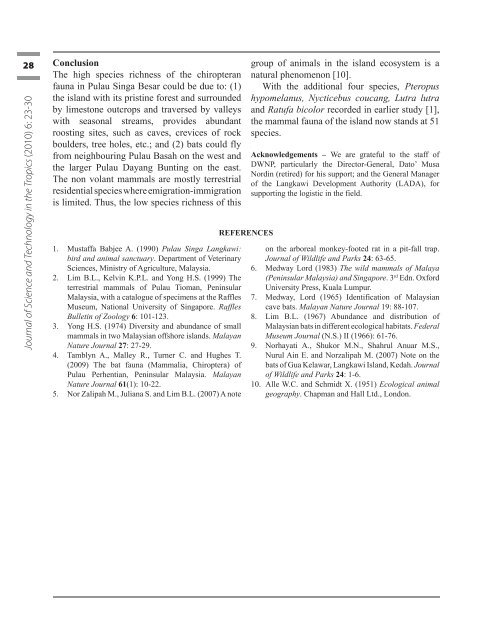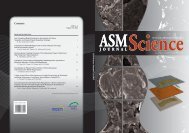Download - Akademi Sains Malaysia
Download - Akademi Sains Malaysia
Download - Akademi Sains Malaysia
You also want an ePaper? Increase the reach of your titles
YUMPU automatically turns print PDFs into web optimized ePapers that Google loves.
28<br />
Journal of Science and Technology in the Tropics (2010) 6: 23-30<br />
Conclusion<br />
The high species richness of the chiropteran<br />
fauna in Pulau Singa Besar could be due to: (1)<br />
the island with its pristine forest and surrounded<br />
by limestone outcrops and traversed by valleys<br />
with seasonal streams, provides abundant<br />
roosting sites, such as caves, crevices of rock<br />
boulders, tree holes, etc.; and (2) bats could fly<br />
from neighbouring Pulau Basah on the west and<br />
the larger Pulau Dayang Bunting on the east.<br />
The non volant mammals are mostly terrestrial<br />
residential species where emigration-immigration<br />
is limited. Thus, the low species richness of this<br />
1. Mustaffa Babjee A. (1990) Pulau Singa Langkawi:<br />
bird and animal sanctuary. Department of Veterinary<br />
Sciences, Ministry of Agriculture, <strong>Malaysia</strong>.<br />
2.<br />
3.<br />
4.<br />
5.<br />
Lim B.L., Kelvin K.P.L. and Yong H.S. (1999) The<br />
terrestrial mammals of Pulau Tioman, Peninsular<br />
<strong>Malaysia</strong>, with a catalogue of specimens at the Raffles<br />
Museum, National University of Singapore. Raffles<br />
Bulletin of Zoology 6: 101-123.<br />
Yong H.S. (1974) Diversity and abundance of small<br />
mammals in two <strong>Malaysia</strong>n offshore islands. Malayan<br />
Nature Journal 27: 27-29.<br />
Tamblyn A., Malley R., Turner C. and Hughes T.<br />
(2009) The bat fauna (Mammalia, Chiroptera) of<br />
Pulau Perhentian, Peninsular <strong>Malaysia</strong>. Malayan<br />
Nature Journal 61(1): 10-22.<br />
Nor Zalipah M., Juliana S. and Lim B.L. (2007) A note<br />
REFERENCES<br />
group of animals in the island ecosystem is a<br />
natural phenomenon [10].<br />
With the additional four species, Pteropus<br />
hypomelanus, Nycticebus coucang, Lutra lutra<br />
and Ratufa bicolor recorded in earlier study [1],<br />
the mammal fauna of the island now stands at 51<br />
species.<br />
Acknowledgements – We are grateful to the staff of<br />
DWNP, particularly the Director-General, Dato’ Musa<br />
Nordin (retired) for his support; and the General Manager<br />
of the Langkawi Development Authority (LADA), for<br />
supporting the logistic in the field.<br />
on the arboreal monkey-footed rat in a pit-fall trap.<br />
Journal of Wildlife and Parks 24: 63-65.<br />
6. Medway Lord (1983) The wild mammals of Malaya<br />
(Peninsular <strong>Malaysia</strong>) and Singapore. 3rd Edn. Oxford<br />
University Press, Kuala Lumpur.<br />
7. Medway, Lord (1965) Identification of <strong>Malaysia</strong>n<br />
cave bats. Malayan Nature Journal 19: 88-107.<br />
8. Lim B.L. (1967) Abundance and distribution of<br />
<strong>Malaysia</strong>n bats in different ecological habitats. Federal<br />
Museum Journal (N.S.) II (1966): 61-76.<br />
9. Norhayati A., Shukor M.N., Shahrul Anuar M.S.,<br />
Nurul Ain E. and Norzalipah M. (2007) Note on the<br />
bats of Gua Kelawar, Langkawi Island, Kedah. Journal<br />
of Wildlife and Parks 24: 1-6.<br />
10. Alle W.C. and Schmidt X. (1951) Ecological animal<br />
geography. Chapman and Hall Ltd., London.<br />
Jostt vol 6.indd 28 7/22/10 10:09:05 PM

















